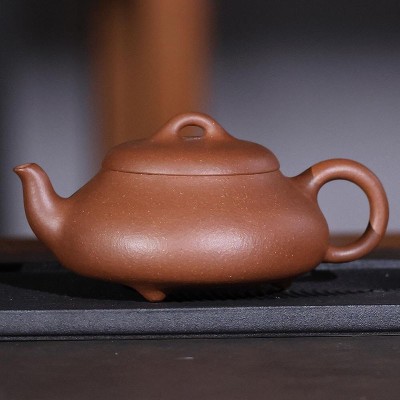





"Shipiao" Yixing teapot- this zisha teapot is a traditional Chinese tea set characterized by its gourd-like or calabash-like shape, with a small top and large bottom, a sturdy and short spout, and a pyramid-shaped body that exudes elegance. Made from high-quality purple clay material, this teapot is known for its hardness and durability, as well as its stable and easy-to-use design. The short and powerful straight spout ensures a smooth and steady flow of water, while the pyramid-shaped body adds a touch of sophistication to any tea ceremony.
 Delivery
Delivery
Free shipping within 1 to 3 days. ETA:5-7 days
 Returns
Returns
Within 28 days after delivery date.
 Security
Security
SSL | GDRP used to ensure information security.
Guarantee safe & secure checkout
Data sheet
I recently added this yixing teapot to my collection, and I am amazed by its excellent heat retention. The clay material is exceptional at keeping the tea warm, and the pour is smooth and precise. The unique design and functionality make it a standout teapot in my collection. I highly recommend it to anyone looking for a special and high-quality teapot.
I recently received this yixing teapot as a gift, and I am absolutely in love with it. The lovely design and the unique charm of the clay material make it a standout piece. The pour is smooth and the tea tastes amazing when brewed in it. It has quickly become a cherished addition to my tea ritual, and I couldn't be happier with it.
"Shipiao" Yixing teapot- this zisha teapot is a traditional Chinese tea set characterized by its gourd-like or calabash-like shape, with a small top and large bottom, a sturdy and short spout, and a pyramid-shaped body that exudes elegance. Made from high-quality purple clay material, this teapot is known for its hardness and durability, as well as its stable and easy-to-use design. The short and powerful straight spout ensures a smooth and steady flow of water, while the pyramid-shaped body adds a touch of sophistication to any tea ceremony.
The "Dabin-Ruyi" is a classic Yixing teapot designed and made for Dabin during the Ming Dynasty. Dabin designed this teapot with the meaning of "everything goes as desired" .The lid is convex and serves as a cover. The lid is decorated with four symmetrical Ruyi patterns, with a thickness of about 1 millimeter and exquisite craftsmanship. The knob is flat and round, and there is an air hole in the center of the lid that is connected to the knob. The hole in the lid is large, while the hole in the knob is small and round, with precise workmanship. The "sanwan" spout are inwardly curved, giving the teapot a dignified and refined appearance. The Dabin-Ruyi teapot is simple and elegant, with a grandeur that is not overwhelming, fully reflecting the style of Dabin's teapot making.
"Xishi" yixing teapot is the quintessential model and the most popular style of Yixing clay teapot. It boasts a round and plump body, a cut lid, a short spout, and an inverted handle. The pot's body resembles the full breast of a young woman, while the knob on the lid is shaped like a nipple. The bottom of the pot curves inward naturally, and the handle is fashioned like an upside-down ear, reminiscent of the hairstyle of ancient Chinese women. When pouring tea, the handle resembles the slender waist of a beautiful woman. The Xishi teapot is renowned for its unique ability to brew tea, allowing the tea leaves to fully expand and release a more intense aroma and flavor.
"Meirenjian" yixing teapot resembles an ancient woman, dignified and lovely, with a hint of palace elegance and grace, yet without losing the charm of a young lady. The shape is full and elegant, mainly reflecting the roundness of the pot body. The pot cover and the pot body seem to be integrated without any gaps. When touched by hand, one can feel its warmth.
"De" means morality,"zhong" means "bell",The bell-shaped lid and body of this zisha teapot symbolize a person with noble character, frugality, and simplicity. Owning this teapot is seen as a sign of being a true gentleman, as it represents the values of humility and refinement.
The Xishi yixing teapot is the quintessential model and the most popular style of Yixing clay teapot. It boasts a round and plump body, a cut lid, a short spout, and an inverted handle. The pot's body resembles the full breast of a young woman, while the knob on the lid is shaped like a nipple. The bottom of the pot curves inward naturally, and the handle is fashioned like an upside-down ear, reminiscent of the hairstyle of ancient Chinese women. When pouring tea, the handle resembles the slender waist of a beautiful woman. The Xishi teapot is renowned for its unique ability to brew tea, allowing the tea leaves to fully expand and release a more intense aroma and flavor.
"Hehuan" means "all happy",the zisha art master- "Mansheng" was inspired by the beautiful and harmonious sound of the cymbals coming together during the celebration. He believed that this sound brought joy and happiness to people, so he used the shape of the cymbals as a model to design the Hehuan teapot. He named it after the joyous sound they made when struck together, and the teapot's unique shape and design symbolize the harmony and beauty of life.
"Fanggu" Yixing Teapot - This zisha teapot has an antique cylindrical body shaped like a drum, with a short neck imitating the shape of a drum pot. The spout is also designed to imitate the shape of a drum pot spout, with a straight line. Its advantages include excellent heat preservation, natural color, comfortable texture, and long service life. The "Fanggu" teapot is a unique and elegant choice for tea lovers and collectors alike.
"Shipiao" Yixing teapot- this zisha teapot is a traditional Chinese tea set characterized by its gourd-like or calabash-like shape, with a small top and large bottom, a sturdy and short spout, and a pyramid-shaped body that exudes elegance. Made from high-quality purple clay material, this teapot is known for its hardness and durability, as well as its stable and easy-to-use design. The short and powerful straight spout ensures a smooth and steady flow of water, while the pyramid-shaped body adds a touch of sophistication to any tea ceremony.
"Bafang"-The octagonal yixing teapot is a relatively rare type of square-shaped purple clay teapot. The lines and surfaces are straight, flat, and distinct, giving people a sense of cleanliness, sharpness, and elegance. The rules for creating a square-shaped teapot require "smooth lines, distinct contours, and a stable and solemn appearance," with straight and horizontal lines as the main elements, and curved and thin lines as the auxiliary elements. In addition to requiring symmetry between the mouth, lid, spout, handle, and body of the teapot, the square shape also requires "roundness within squareness, seeking change within the squareness, and uniformity between the mouth and lid, with a balance between rigidity and flexibility."
The design of the Palace Lamp "Gongdeng" in the Yongzheng period of the Qing Dynasty. Its prototype was a lantern, designed by an old man from Tuntou Village. Later, the Tuntou Lantern was presented as a tribute to a county-level official who took it to the palace. The Tuntou Lantern was named "Gongdeng" and became an exclusive item for the imperial palace. Later, people replaced the character "Gong" with "Palace," and it became the "Palace Lamp" we know today. The Palace Lamp teapot is designed based on this lantern, often appearing in a square shape with a fresh, natural, and elegant style that is in line with the aesthetic views of ancient people and easily accepted by modern people.
The apple-shaped Yixing teapot is another unique example of zisha teapot. As the name suggests, it is designed to resemble an apple.
The design of the "Xubian" zisha teapot is a combination of the elements of the "Xubian" and the "Gongdeng". "Xubian" refers to the flat shape of the body of the pot, while "Gongdeng" refers to the shape of the lid of the pot, which is like a palace lamp. This design not only retains the characteristics of traditional purple clay pots, but also adds some new elements, making the "Biandeng" more ornamental and collectible.
Pear-shaped yixing teapot,it is one of the pot styles that originated in the Chian Yuan Dynasty and became popular during the China Ming Dynasty. It is named after its pear-like shape.
"Rongtian" yixing teapot takes its inspiration from the "big-bellied" Arhat in Buddhism, named after the saying "a big belly can hold the world's affairs". It is difficult to fully capture the charm of this teapot, as it requires the maker to truly understand its essence. A slightly shorter neck is added to the full-bodied teapot, while the lid is raised to a half-spherical shape, giving it a simple and childlike charm. The teapot has excellent pouring performance and is comfortable to use. Visually, it exudes a dignified and generous aura while embodying depth within simplicity.
"Shipiao" Yixing teapot- this zisha teapot is a traditional Chinese tea set characterized by its gourd-like or calabash-like shape, with a small top and large bottom, a sturdy and short spout, and a pyramid-shaped body that exudes elegance. Made from high-quality purple clay material, this teapot is known for its hardness and durability, as well as its stable and easy-to-use design. The short and powerful straight spout ensures a smooth and steady flow of water, while the pyramid-shaped body adds a touch of sophistication to any tea ceremony.
NOTICE : Cookies ensure the smooth running of our services and improve user experience,Using these, you accept the use of cookies. Learn More.